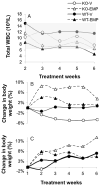Ablation of the ATP-binding cassette transporter, Abca2 modifies response to estrogen-based therapies
- PMID: 22898081
- PMCID: PMC3714854
- DOI: 10.1016/j.biopha.2012.06.007
Ablation of the ATP-binding cassette transporter, Abca2 modifies response to estrogen-based therapies
Abstract
The ATP-binding cassette transporter 2 (ABCA2) is an endolysosomal protein expressed in oligodendrocytes and Schwann cells, prostate, ovary and macrophages. In cell cultures, ABCA2 over-expression has been linked with resistance to the anticancer agent, estramustine phosphate (EMP; a nor-nitrogen mustard conjugate of estradiol). The present study shows that Abca2 knockout (KO) mice have greater sensitivity to a variety of side effects induced by EMP treatment. Chronic EMP (12×100 mg/kg body weight) produced mortality in 36% of KO mice, but only 7% of age-matched wild type (WT). Side effects of the drug were also more prevalent in the KO mouse. For example, during the first week of EMP treatments, 67% of KO males (compared to 6% of WT males) responded with episodic erectile events. In WT mice, ABCA2 protein localized within pene corpuscles, (which rely on modified Schwann cells for amplification of tactile signals) suggesting that the transporter may function in the erectile process. Endothelial nitric oxide synthase (eNOS; a source of nitric oxide during erectile response) levels were similar in WT and KO male penile tissue. Treatment with 100 mg/kg EMP (once daily for four days) elevated serum estradiol and estrone in both WT and KO. However, the circulating levels of these estrogens were higher in KO mice implying a reduced plasma clearance of estrogens as a consequence of ABCA2 ablation. Consistent with the pro-convulsant effects of estrogens, KO mice also displayed an increased incidence of seizures following EMP (14% vs. 0%). Taken together, these data indicate that ABCA2 deficiency renders mice more sensitive to EMP treatment-induced effects implying that the transporter has a role in regulating EMP transport and/or metabolism.
Copyright © 2012. Published by Elsevier SAS.
Conflict of interest statement
The authors declare that they have no conflicts of interest concerning this article.
Figures




Similar articles
-
ATP-binding cassette transporter-2 (ABCA2) as a therapeutic target.Biochem Pharmacol. 2018 May;151:188-200. doi: 10.1016/j.bcp.2017.11.018. Epub 2017 Dec 6. Biochem Pharmacol. 2018. PMID: 29223352 Free PMC article. Review.
-
ABCA2 transporter deficiency reduces incidence of TRAMP prostate tumor metastasis and cellular chemotactic migration.Cancer Lett. 2011 Jan 28;300(2):154-61. doi: 10.1016/j.canlet.2010.09.017. Epub 2010 Oct 30. Cancer Lett. 2011. PMID: 21041019 Free PMC article.
-
Cloning and characterization of human adenosine 5'-triphosphate-binding cassette, sub-family A, transporter 2 (ABCA2).Cancer Res. 2001 Apr 15;61(8):3339-47. Cancer Res. 2001. PMID: 11309290
-
"Skittish" Abca2 knockout mice display tremor, hyperactivity, and abnormal myelin ultrastructure in the central nervous system.Mol Cell Biol. 2007 Jan;27(1):44-53. doi: 10.1128/MCB.01824-06. Epub 2006 Oct 23. Mol Cell Biol. 2007. PMID: 17060448 Free PMC article.
-
The ABCA2 transporter: intracellular roles in trafficking and metabolism of LDL-derived cholesterol and sterol-related compounds.Curr Drug Metab. 2007 Jan;8(1):47-57. doi: 10.2174/138920007779315044. Curr Drug Metab. 2007. PMID: 17266523 Free PMC article. Review.
Cited by
-
ATP-binding cassette transporter-2 (ABCA2) as a therapeutic target.Biochem Pharmacol. 2018 May;151:188-200. doi: 10.1016/j.bcp.2017.11.018. Epub 2017 Dec 6. Biochem Pharmacol. 2018. PMID: 29223352 Free PMC article. Review.
-
Strategies to gain novel Alzheimer's disease diagnostics and therapeutics using modulators of ABCA transporters.Free Neuropathol. 2021;2:33. doi: 10.17879/freeneuropathology-2021-3528. Epub 2021 Dec 13. Free Neuropathol. 2021. PMID: 34977908 Free PMC article.
-
Increased Expression of the ABCA1 and ABCA3 Transporter Genes is Associated with Cisplatin Resistance in Breast Cancer Cells.Asian Pac J Cancer Prev. 2023 Nov 1;24(11):3969-3977. doi: 10.31557/APJCP.2023.24.11.3969. Asian Pac J Cancer Prev. 2023. PMID: 38019257 Free PMC article.
-
The role of ATP-binding cassette transporter A2 in childhood acute lymphoblastic leukemia multidrug resistance.Iran J Ped Hematol Oncol. 2014;4(3):118-26. Epub 2014 Jul 20. Iran J Ped Hematol Oncol. 2014. PMID: 25254091 Free PMC article. Review.
References
-
- Vulevic B, Chen Z, Boyd JT, Davis W, Walsh ES, Jr, Belinsky MG, et al. Cloning and characterization of human adenosine 5′-triphosphate-binding cassette, subfamily A, transporter 2 (ABCA2) Cancer Res. 2001;61:3339–47. - PubMed
-
- Zhou CJ, Inagaki N, Pleasure SJ, Zhao LX, Kikuyama S, Shioda S. ATP-binding cassette transporter ABCA2 (ABC2) expression in the developing spinal cord and PNS during myelination. J Comp Neurol. 2002;451:334–45. - PubMed
-
- Kim WS, Guillemin GJ, Glaros EN, Lim CK, Garner B. Quantitation of ATP-binding cassette subfamily-A transporter gene expression in primary human brain cells. Neuroreport. 2006;17:891–6. - PubMed
-
- Broccardo C, Nieoullon V, Amin R, Masmejean F, Carta S, Tassi S, et al. ABCA2 is a marker of neural progenitors and neuronal subsets in the adult rodent brain. J Neurochem. 2006;97:345–55. - PubMed
-
- Kaminski WE, Piehler A, Pullmann K, Porsch-Ozcurumez M, Duong C, Bared GM, et al. Complete coding sequence, promoter region, and genomic structure of the human ABCA2 gene and evidence for sterol-dependent regulation in macrophages. Biochem Biophys Res Commun. 2001;281:249–58. - PubMed
Publication types
MeSH terms
Substances
Grants and funding
LinkOut - more resources
Full Text Sources
Medical
Molecular Biology Databases
Research Materials

